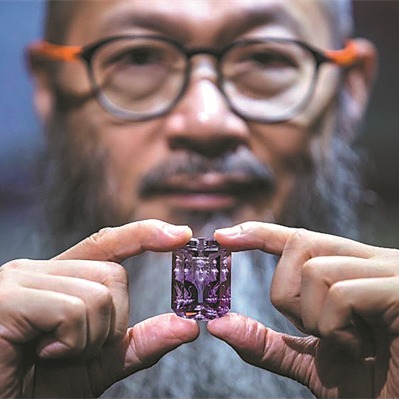



Acclaimed artist Wallace Chan will present his jewelry collection at this year's Shanghai expo, Zhang Kun reports.
Chinese artist and sculptor Wallace Chan's jewelry collection is expected to be a key highlight at this year's China International Import Expo, which will be held in Shanghai from Nov 5 to 10.
Valued at nearly 560 million yuan ($77.78 million), the collection contains 150 pieces of jewelry that will be showcased in the solo exhibition Wallace Chan: Earthly, Unearthly.
The centerpiece of the show will be Stilled Life, a sculpture depicting a cicada crouching on a bamboo leaf. The artwork is made of imperial jadeite, diamonds, crystal and other gemstones. First exhibited at the Antiques Biennale in Paris in 2012, the artwork has "grown" over the years, with additional bamboo branches, leaves and a tiny spider added.

Chan, who was the first Chinese artist to participate in the Antiques Biennale, recently explained the symbolic meaning of cicadas in Chinese mythology during a preview of some of the exhibits in Amanyangyun Shanghai, a luxury resort and hotel in the city's suburban Minhang district.
"These insects spend a couple of years underground before climbing along the tree trunk to go through metamorphosis overnight, spreading their wings to become singing creatures in summertime," he says.
Ancient Chinese took cicadas as a symbol of nirvana, he says, adding that since the Han Dynasty (206 BC-AD 220), people have carved forms of the insect with beautiful stones.
Cicada pendants symbolized nobility and unsullied virtue, and jade cicadas were put in the mouth of the deceased before they were buried, a move that symbolized rebirth and immorality, he adds.

To highlight the purity and brightness of jadeite, Chan invented a new polishing technique that allows the green refraction to magnify and sharpen the deep green colors of the stone. The technique was patented in 2002.
Chan also created gem-setting techniques inspired by the mortise and tenon joints in ancient Chinese furniture to fit the gemstones perfectly against each other instead of using conventional metal claws.
A dedicated researcher and innovator of materials and technology, Chan is widely recognized for his invention of a new porcelain that was named after him. "I remember when I was little, my mother was very upset with me as I dropped a spoon and it broke to pieces," Chan says. "I wondered if there was a way to prevent porcelain from breaking so easily … that is why I created this new version."

After seven years of experimentation, he created the Wallace Chan porcelain, a 100-percent china material that is five times harder than steel.
The strength of the porcelain, he explains, is achieved by repeatedly baking the material under strictly controlled temperatures. This process also gives Wallace Chan porcelain its unique color and luster.
His first jewelry creation using this material was A New Generation, a ring with three large sapphires surrounded by diamonds and aquamarines. The piece was collected by the British Museum in London in 2019.
Born into a poor family in Fujian province in 1956, Chan moved to Hong Kong with his parents when he was 5 years old. He quit school at the age of 16 to become an apprentice in a sculpture studio, where he learned to carve Buddha statues and legendary figures out of precious stones.

He recalls the environment being highly competitive as the young apprentices would all compete to win the master's favor.
Chan stood out from the competition as he was a keen learner who quickly improved his skills. When some other apprentices "became jealous and turned against him", he left the studio to open his own practice. His working on jade had less margin for error as the material was prohibitively expensive. Consequently, people working with jade had to carefully study it and be precise in their actions.
As Chan improved his understanding of precious stones, he searched for new tools and found drills used by dentists rather handy. But there was a catch — such tools could easily cause the precious stone to crack.
To address the issue, he modified the equipment and carried out the carving process in water to disperse the heat and alleviate the tension created. This resulted in his first major breakthrough.
Using his new equipment and technique, which involved cameos and intaglios, he created Now and Always, a pendant featuring a facial image inspired by the goddesses of Horae in an aquamarine gemstone. The technique was invented as the Wallace Cut in 1987.

His ingenuity did not go unnoticed as he later became the first Chinese artist to gain international recognition in the world of jewelry-making that has for centuries been dominated by Western artists.
Chan's works have been exhibited at prestigious fairs, such as the London Art Fair and the European Fine Art Fair in the Netherlands, as well as at important cultural institutions, including the American Museum of Natural History in New York.
While his masterpiece jewelry creations were collected by China's wealthy elite and European royals, Chan hoped his creations would become available in museum collections and be a part of the shared human civilization.
In recent years, Chan has extended his study of materials, especially metal titanium, to create much bigger sculptures. He presented his first large-scale sculpture and installation exhibition, Titans: A Dialogue Between Materials, Space and Time at Fondaco Marcello in Venice, Italy. The largest piece in this collection measures 10 meters in height.
Chan's sculpture exhibition Totem is ongoing at Fondaco Marcello as part of the ongoing 59th edition of the Venice Art Biennale.
"A pioneer in using titanium for art making, Chan has released, experimented and discovered the space age metal's potential not only in jewelry but also in his large-scale sculptures," writes a review of the exhibition published on Mousse, an art magazine in Italy.
If you have any problems with this article, please contact us at app@chinadaily.com.cn and we'll immediately get back to you.